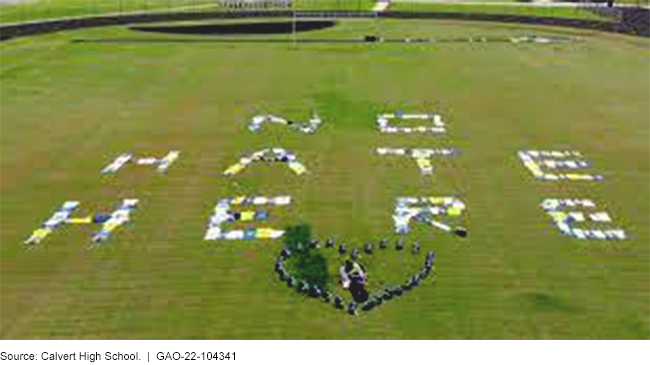K-12 Education: Students' Experiences with Bullying, Hate Speech, Hate Crimes, and Victimization in Schools
Fast Facts
Each year, millions of K-12 students experience hostile behaviors like bullying, hate speech, hate crimes, or assault. In school year 2018-19, about 1.3 million students, ages 12 to 18, were bullied for their race, religion, national origin, disability, gender, or sexual orientation.
The Department of Education resolved complaints of hostile behaviors faster in recent years, but more complaints are being dismissed and fewer are being filed. Some civil rights experts said they lost confidence in Education's ability to address civil rights violations in schools—citing Education's rescission of guidance that clarified civil rights protections.
The National Suicide Prevention Lifeline—(800) 273-8255—is a federally managed and funded hotline that offers free, confidential support from trained counselors for individuals in crisis.
After experiencing incidents of racism, high school community members made a statement against hate.

Highlights
What GAO Found
Students experience a range of hostile behaviors at schools nationwide, according to GAO's analysis of nationally generalizable surveys of students and schools. About one in five students aged 12 to 18 were bullied annually in school years 2014-15, 2016-17, and 2018-19. Of students who were bullied in school year 2018-19, about one in four students experienced bullying related to their race, national origin, religion, disability, gender, or sexual orientation. About one in four of all students aged 12 to 18 saw hate words or symbols written in their schools, such as homophobic slurs and references to lynching. Most hostile behaviors also increased in school year 2017-18, according to our analysis of the school survey. Hate crimes—which most commonly targeted students because of their race and national origin—and physical attacks with a weapon nearly doubled (see figure). Sexual assaults also increased during the same period.
Hostile Behaviors in K-12 Public Schools, School Years 2015-16 to 2017-18

Nearly every school used programs or practices to address hostile behaviors, and schools' adoption of them increased from school year 2015-16 to 2017-18, according to our analysis of the school survey. About 18,000 more schools implemented social emotional learning and about 1,200 more used in-school suspensions. Additionally, 2,000 more schools used school resource officers (SRO)—career officers with the ability to arrest students—in school year 2017-18. SROs' involvement in schools, such as solving problems, also increased.
The Department of Education resolved complaints of hostile behaviors faster in recent years, due in part to more complaints being dismissed and fewer complaints being filed. In the 2019-20 school year, 81 percent of such resolved complaints were dismissed, most commonly because Education's Office for Civil Rights (OCR) did not receive consent to disclose the complainant's identity to those they filed the complaint against. Complaints of hostile behaviors filed with OCR declined by 9 percent and 15 percent, respectively, in school years 2018-19 and 2019-20. Civil rights experts GAO interviewed said that in recent years they became reluctant to file complaints on students' behalf because they lost confidence in OCR's ability to address civil rights violations in schools. The experts cited, in part, Education's rescission of guidance to schools that clarified civil rights protections, such as those for transgender students. Since 2021, Education has started reviewing or has reinterpreted some of this guidance.
Why GAO Did This Study
Hostile behaviors, including bullying, harassment, hate speech and hate crimes, or other types of victimization like sexual assault and rape, in schools can negatively affect K-12 students' short- and long-term mental health, education, income, and overall well-being. According to Education's guidance, incidents of harassment or hate, when motivated by race, color, national origin, sex (including sexual orientation and gender identity), or disability status can impede access to an equal education. In certain circumstances, these kinds of incidents may violate certain federal civil rights laws, which Education's OCR is tasked with enforcing in K-12 schools.
GAO was asked to review hostile behaviors in K-12 schools. This report examines (1) the prevalence and nature of hostile behaviors in K-12 public schools; (2) the presence of K-12 school programs and practices to address hostile behaviors; and (3) how Education has addressed complaints related to these issues in school years 2010-11 through 2019-20.
GAO conducted descriptive and regression analyses on the most recent available data for two nationally generalizable federal surveys: a survey of 12- to 18-year-old students for school years 2014-15, 2016-17, and 2018-19, and a survey of schools for school years 2015-16 and 2017-18. GAO also analyzed 10 years of civil rights complaints filed with OCR against schools; reviewed relevant federal laws, regulations, and documents; and interviewed relevant federal and national education and civil rights organization officials. GAO incorporated technical comments from Education as appropriate.
For more information, contact Jacqueline M. Nowicki at (617) 788-0580 or nowickij@gao.gov.
